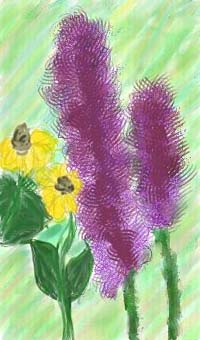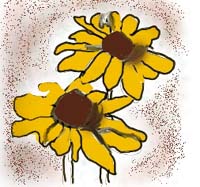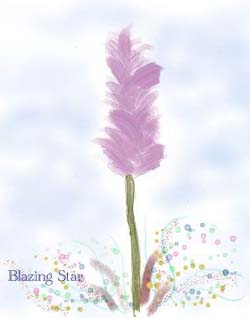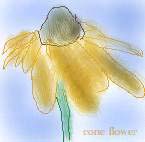 Objective:
Students will increase their computer graphics skills and be able to to trace
and paint botanicals from digital photographs they take of prairie plants
using computer-aided artistic techniques in Painter Classic Software and with
the Wacom Tablet and stylus. (available for Windows for about $99.)
Objective:
Students will increase their computer graphics skills and be able to to trace
and paint botanicals from digital photographs they take of prairie plants
using computer-aided artistic techniques in Painter Classic Software and with
the Wacom Tablet and stylus. (available for Windows for about $99.)
Grades: 6th and
up
Time Required: 20 minutes outside taking digital photographs of prairie
plants; 10-15 minutes downloading pictures into a computer and viewing them
in Photoshop™ to choose and crop the best one; 5 minutes to set preferences
for stylus; 15 minutes to experiment with the painting tools in the software
to find those that will fit the plant picture; 30+ minutes to trace and paint
a computer-paint version using Painter Classic; save and print. (total 90-120
minutes)
Motivation:
An interesting artistic and scientific career is that of botanical artist
and illustrator. Some botanical illustrators use computers to create their
drawings. Graphic artists may also have a need to create botanicals on their
computer.
Materials:
computer
Wacom Tablet and Graphire2 stylus, which comes with Painter Classic
software.
digital camera
color printer
 Procedure:
Procedure:
- Students will go outdoors, on a field trip to a prairie, or, if this is
not possible, find digital images of prairie flowers (closeups of the top
of the plant are best). It is always best to take your own pictures, rather
than run the risk of copying a copyrighted one. If you take the picture,
you also remember the physical details of the plant better because you saw
it up close.
- Students will download the images to their hard drive or disk. They will
then choose the image that has the best composition, size, detail, and possibility
to become a good small painting. They may have to crop it or resize it in
Photoshop or some other photo software.

- Students will open the Wacom software to preferences and set the weight
of the stylus and eraser to their hand, according to directions in the manual.
Often, about two-thirds of the way to firm is an adequate setting for most
people to achieve delicate lines with light pressure and thickerlines with
heavier pressure of the stylus.
- Students will open Painter Classic and "play" with the painting
tools for 15 minutes, trying out the colors, the pens, pencils, brushers,
and their variations, as well as brush sizes and other settings. They will
look for tools that mimic the textures found in their chosen plant. They
can use UNDO to erase, or use the eraser.
- Students will open their image in Painter Classic. Following instructions,
they will select, backspace (delete) and open the tracing paper for it.
On this new transparent layer they will enter a painted background of their
choice (sky, watercolor wash, etc.). Then they will trace or paint their
prairie plant with the software's tools.
- When satisfied with their painting, or when time has expired, students
will save their painting to a disk. To print it out, they can set the preferences
to Print Full Page to get a large printout. Printing on textured paper makes
an interesting effect, although paper textures and lighting can be adjusted
in the software.
 Assessment:
Assessment:
- Paintings show a closeup view of a plant with a background in a balanced
composition. (5 points or less.)
- Painting mimics the textures and colors of the original thorough use of
tools. (10 points or less)
- Painting should show the various parts of the plant, such as flower, stem,
leaves, even the reproductive parts. (5 points or less)
Illinois State Board
of Education Goals and Standards Addressed:
Visual Arts B: Apply skills and knowledge necessary to create and perform
in one or more of the arts.
26.A.2e: Describe the relationships among media, tools/technology and
processes.
26.A.3e: Describe how the choices of tools/technologies and processes
are used to create specific effects in the arts.
High School
26.B.5: Create and perform a complex work of art using a variety of
techniques, technologies and resources and independent decision making.
27.A.5: Analyze how careers in the arts are expanding based on new
technologies and societal changes.
Science:
13.B.2a: Explain how technology is used in science for a variety of purposes.
13.B.2b
Describe the effects on society of science and technological innovations
such as the computer.

